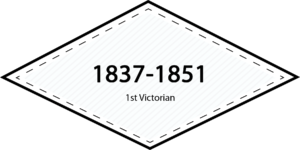
“Age of Expansion”
Expansion of ideas, inventions, & dresses

—— THE ERA IN BRIEF ——
Society in American & Europe were prospering with the development of great ideas like indoor plumbing & the shopping mall. With the invention of the crinoline hoop skirt & metal grommets, women made themselves into “Belles” literally & figuratively, following the lead of a tiny-waisted 18 year old Queen Victoria of England who had just taken the throne. At the same time “49’ers” were panning for gold in California, Charles Worth was inventing a “costume” for every event, while paisley was up & bloomers were down in popularity.

—— PORTRAITS OF REAL WOMEN OF THE ERA ——
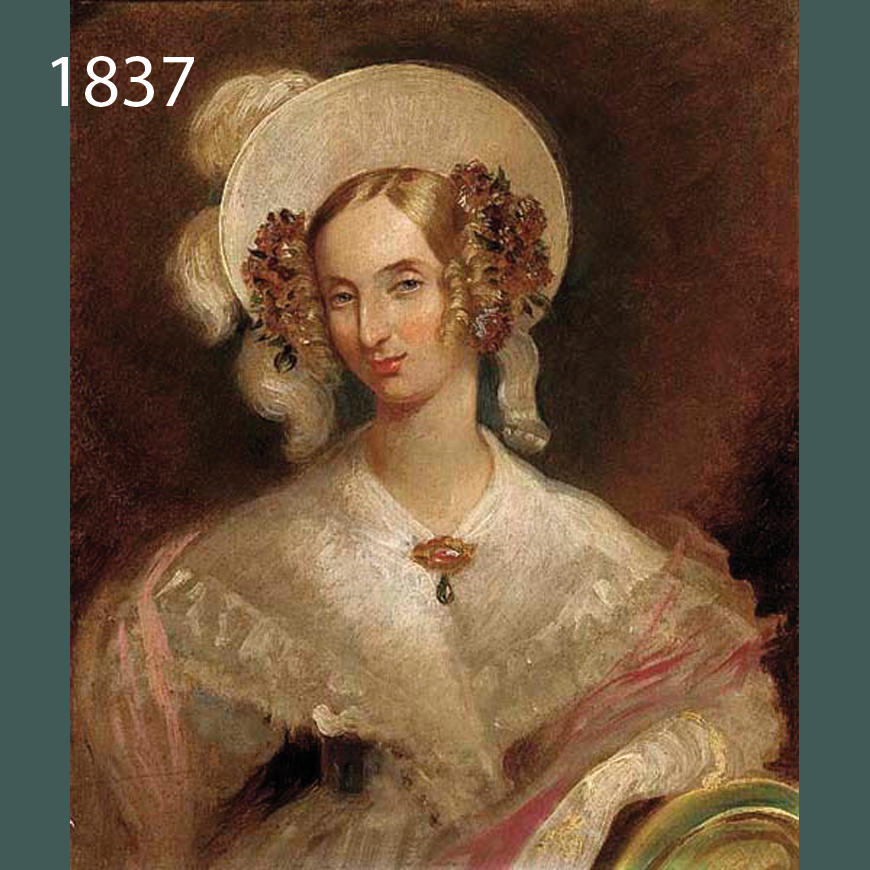
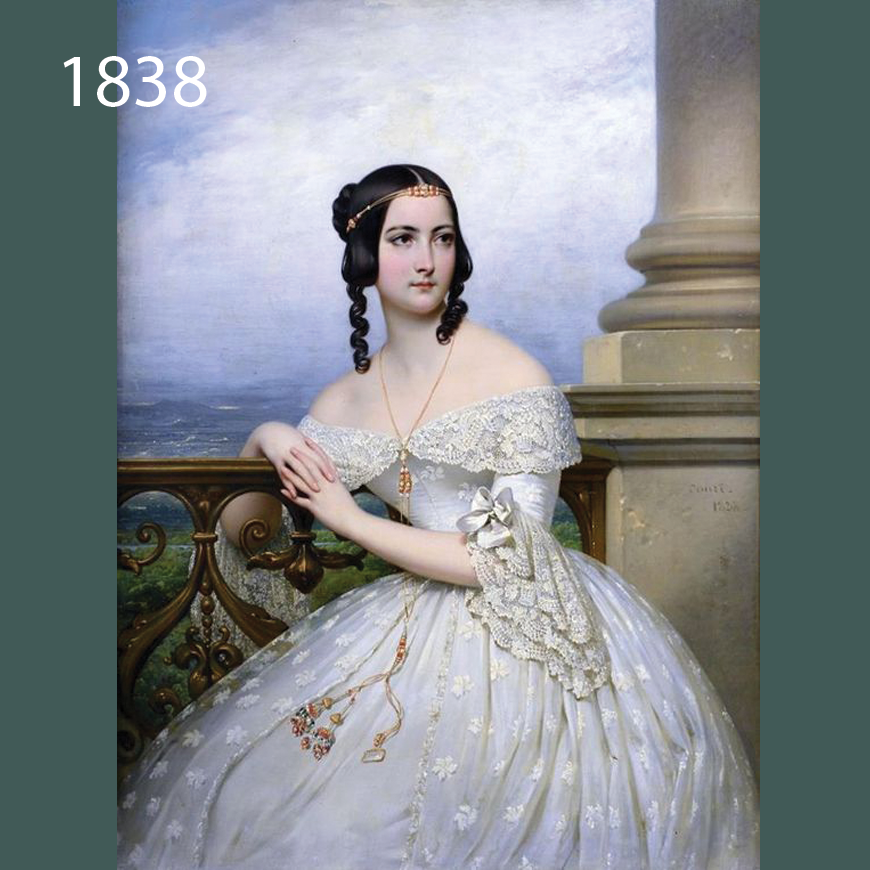
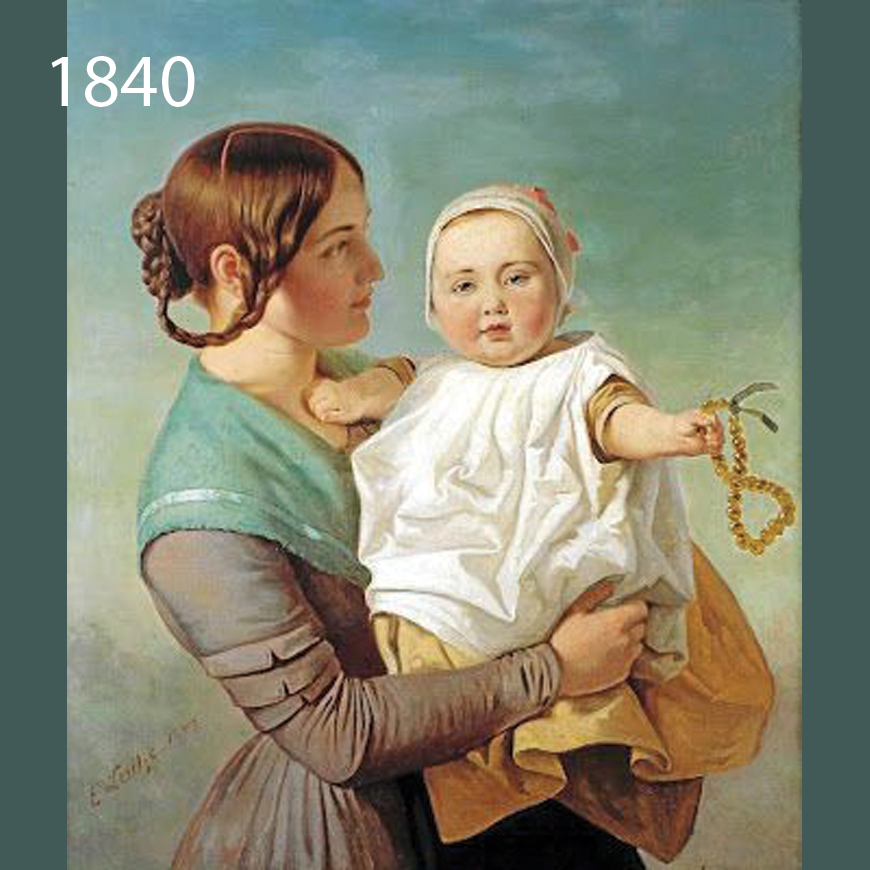
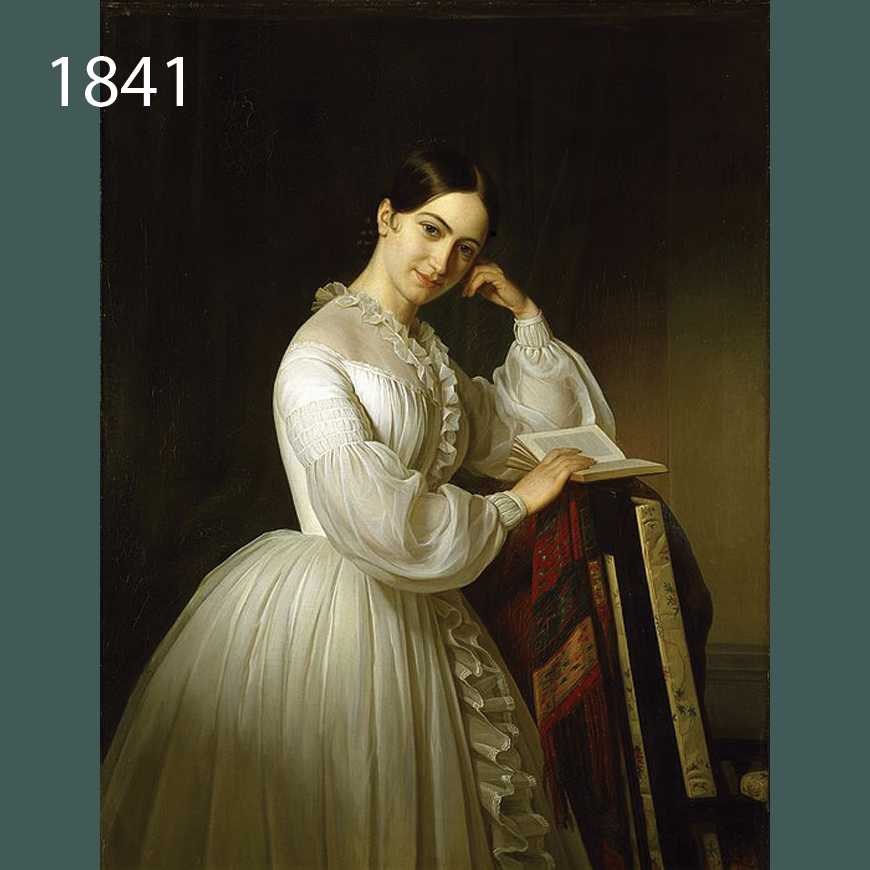
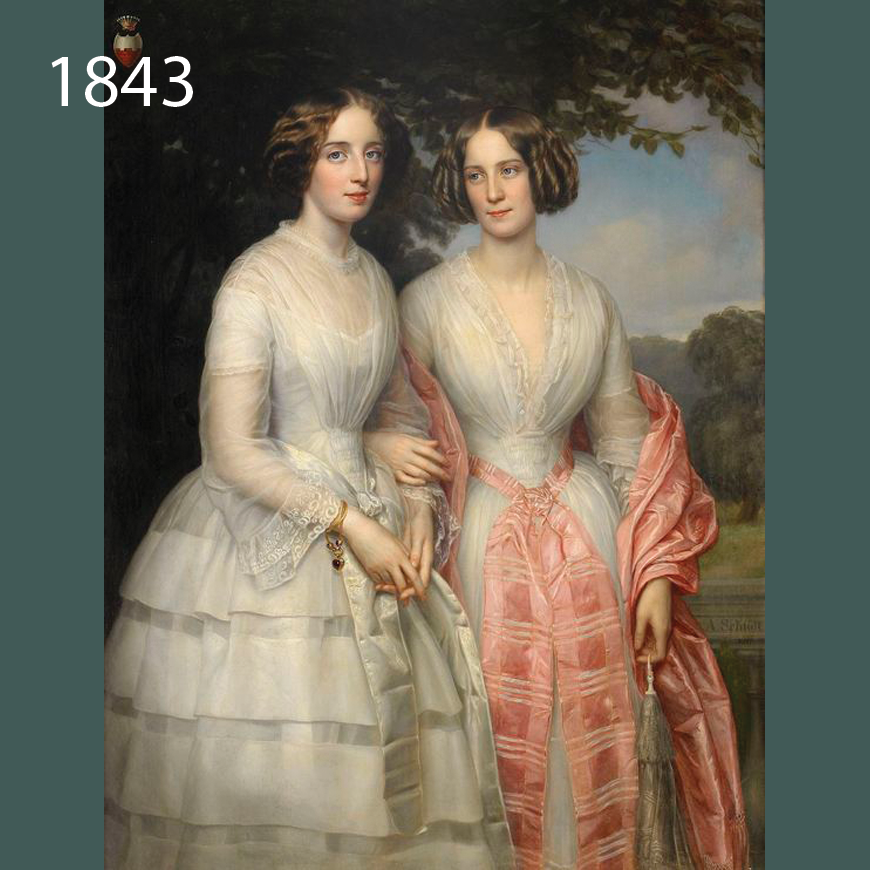
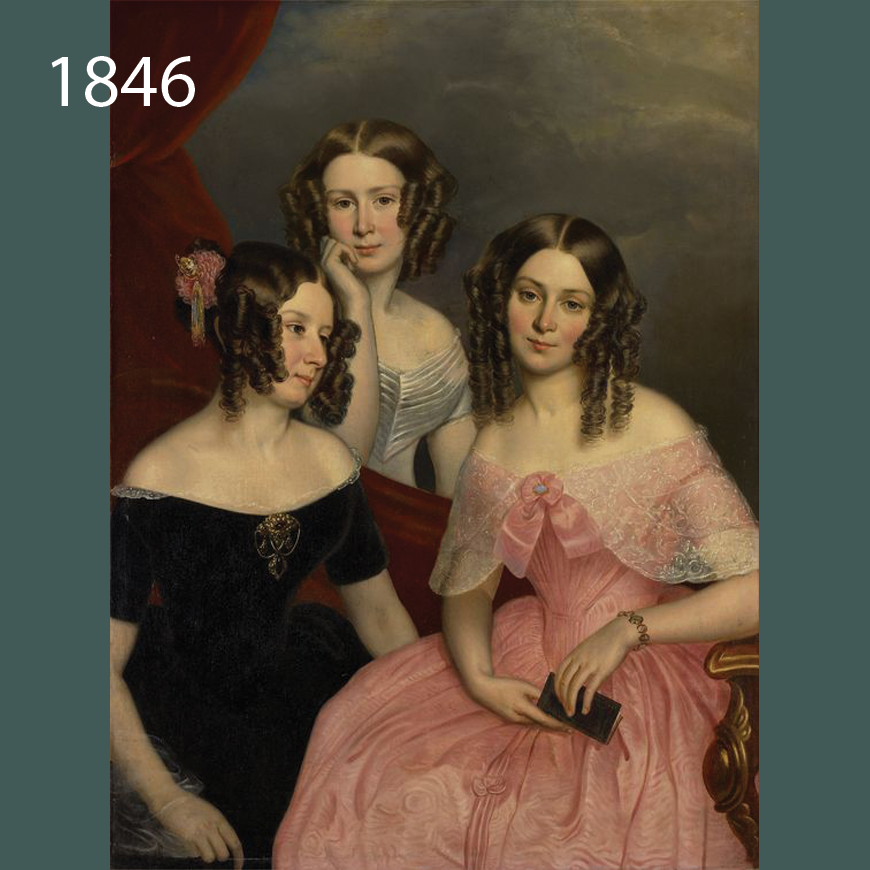
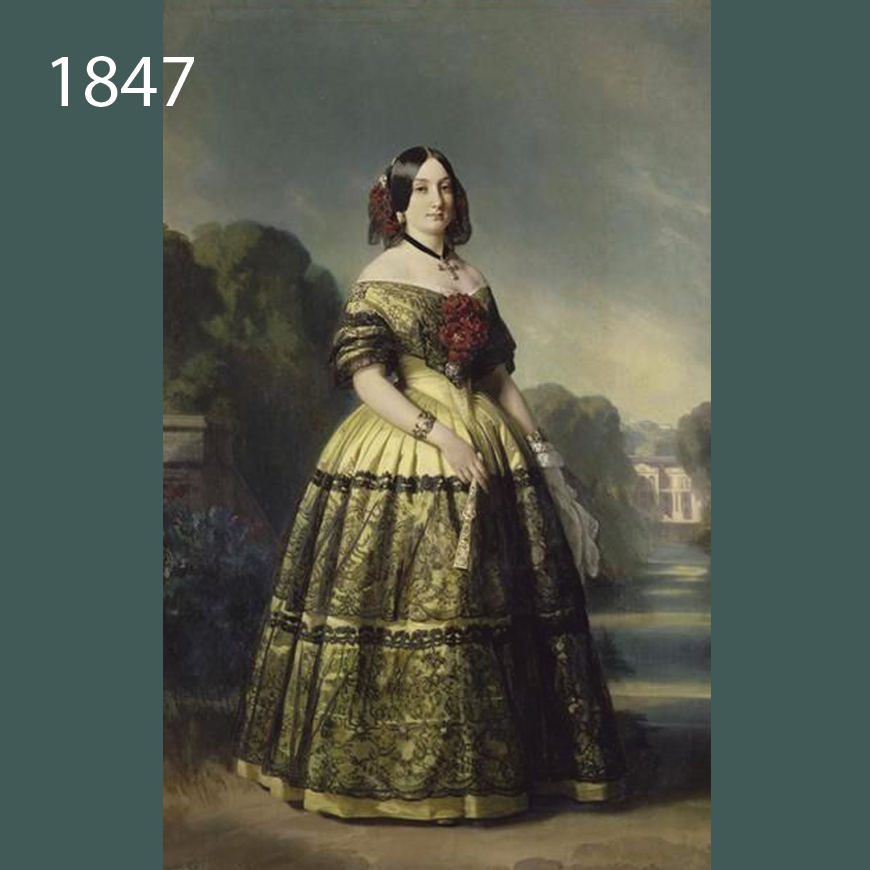
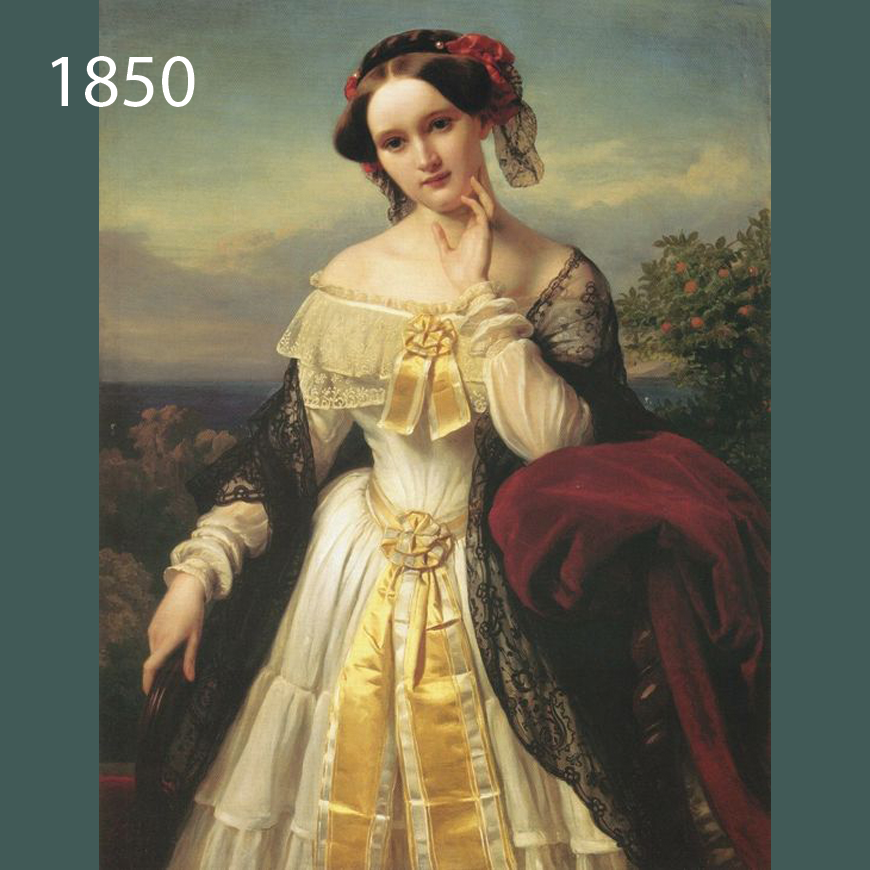

—— WORLD SITUATION ——
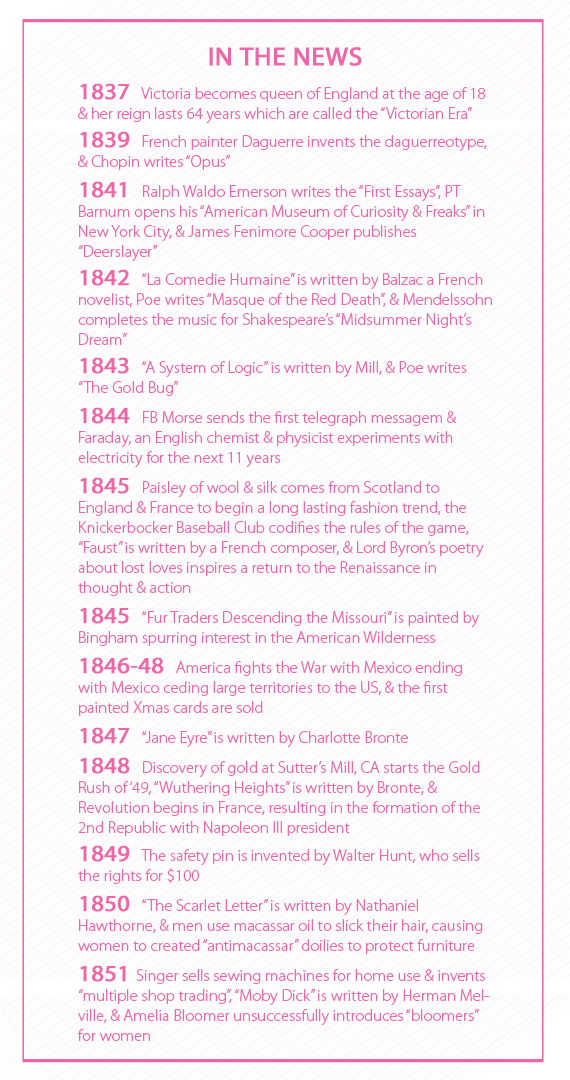
- Queen Victoria came to the throne in 1837 at the age of 18, & would dominate history & world fashion until the next century
- Victoria’s rigid disciplinary standards for 64 years set the “Victorian Eras”
- Under Victoria’s rules, it was improper to even say the world “legs”, let alone look at them under a woman’s garments during this era
- Everything Victoria did was to spur the English economy
- Countries worldwide flourished with improvements on steam engines in all industries & science
- Indoor plumbing, gas lighting, & fast transport changed lives & status of all classes & peoples
- America acquired Nevada, New Mexico, & California in 1848 in a treaty with Mexico
- There was another Revolution in France in 1848, which cut off communication & trade from that country & others
- Gold was discovered in California, starting the gold rush & western expansion in the US
- America went to war with Mexico 1846-48, ending with Mexico ceding large territories to America
- Literature such as “Moby Dick” & “Uncle Tom’s Cabin” expressed ideas of pre-Civil War in America


—— INTERESTING FACTS ——
DRESSMAKING
- Society in Europe & America was prospering
- Population was growing, especially in urban areas
- The idea of standardized clothes was still distasteful to many women, so dressmakers were still in vogue
- The sewing machine, now improved for mass production use, did not help with women’s clothing as much as with men’s, because women disliked uniformity
- Dressmakers even with sewing machines were hard pressed to keep up with demand for clothing
- It was more profitable for a dressmaker to hire out work to the elderly or young rather than use a factory
- Dressmakers had physical shops where they constructed, fit, & sold garments
- Clothes for upper classes were almost all still made by the visiting dressmaker, or customized by the large department stores
- In 1847, an American man with his mother started the successful Royal Worcester Corset Company which stayed in business until 1955
- Royal Worcester American corsets were the most popular & commonly purchased at this time
- Most corset manufacturers were creating a standardized corset & then fitting women into them
- RW designs reversed that thought process in that they were based on a natural line, & then adapted to the function or purpose; e.g. sports, evening gowns, breastfeeding, etc.
- Royal Worcester developed use of the couteil fabric that was functional & quality for a reasonable price, & would be used in corsets forward
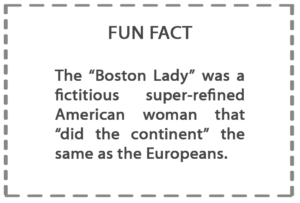
READY-MADE
- There were huge shopping malls with department stores in Paris operating at their peak in the 1840’s & 1850’s including Galeries du Commerce et Industrie, Palace Bonne-Nouveau, & Grandes Halles
- Unlike today’s malls, these included inside custom dressmaking shops as well as ready-made items of all sorts from clothing to perfumes to household goods
- Ready-made applied mostly to cloaks, shawls, etc that a dressmaker would build during the “off season” in her large shop with apprentices
- Ready-made meant garments were pre-made in general pattern sizes, & then fit to the customer in the dressmaker or department store
- There was no such thing as “multiple” or “off the rack” until later in the decade
- Most ordinary women’s clothing was provided in stores. With buses, & railways booming by 1853, shoppers could easily come to the shopping district
- Drugstores were opened in every department store, selling cosmetics
- By the 1840’s every drugstore had a cosmetician who sold cosmetics with the goal of enhancing “naturalness” & fixing men’s black eyes
PRODUCTION, PATTERNS, & MARKETING
- Paper patterns made the home garment-making industry feasible, but the sewing machine was not yet refined for home use
- Paper patterns were used by dressmakers who switched from the draped design of previous eras to flat pattern design
- Designers through upcoming eras would go back & forth from draped to flat pattern design
- Because mass production meant cutting & then assembling 100’s of sleeves, or collars, or bodices instead of building the whole garment, flat pattern design was more efficient & less costly for factory production
- Lady’s fashion magazines like “Godey’s Lady’s Book” described the current fashion trends for all who could afford to buy the book with its hand-colored illustrations
- “Godey’s Lady’s Book” usually included patterns in standardized sizes based on the “proportionate principals”
- Wealthy women would give the patterns to their dressmaker to make
- Non-wealthy women would not be sewing their own “Godey’s” fashions anyway, but rather a lesser version of it, so lower classes obtained patterns through catalogs or department stores
- Fashion magazines were used almost exclusively by the wealthy & elite
- Photography became common in use by 1840 which allowed women to see what a fashion actually looked like
- Instead of word of mouth, use of old clothing, patterns, samples, or periodicals of past eras used to communicate design, women now most often chose their fashion from photographs
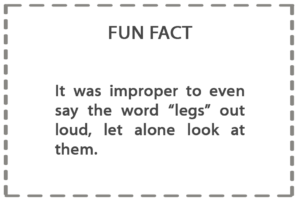

—— FASHION TRENDS ——
AMERICANS EMERGE
- Americans, other than a few railroad, shipping, & banking moguls, really did not have an elite class
- America was still made up of a huge middle class, with the standard of living highest in the world
- While heroes like Lincoln, Clay, & Webster set standards for men, women wanting to be stylish still followed European fashion as they had no American fashion leaders
- Not all American women adhered to European custom
- As with all eras in American fashion history, there were exceptions as women pioneered functional & locally made clothing
- This time period in particular, as the American West was first settled, established its own dress codes for women (discussed as a separate era)
- American fashion, specifically East Coast & Midwest as far as St. Louis, followed the edicts & was restricted by the same rules as Victoria’s Britain was
- The “Boston Lady” was a fashion ideal unique to America. She was a fictitious super-refined American woman that “did the continent” like a Londoner, dressed, spoke, & behaved like European aristocracy, & emulated the ways of the rich
THE RISE OF HAUTE COUTURE
- Early Victorian fashion is jokingly referred to as the time of “drooping ringlets & dragging skirts”
- The era might appear to be the same as the big & embellished previous Rococco, but despite general similarities of line & silhouette, the Early Victorian is actually almost “prudish” in comparison
- Early Victorian differs from the previous Roccoco because of all the strict rules & protocols of fashion dictated by Victoria & the rising designer, Charles Worth
- French “Haute Couture” & the term was invented by Charles Worth
- Worth was an English born designer who told French women what to wear
- What French women wore, was what everybody of European influence, including Americans, wore
- Worth’s concept was that each activity needed its own “costume”, a term he invented
- “Costume” was a complete fashionable ensemble designed & built for a specific function or event to accomplish a specific purpose such as projecting wealth, status, or community standing
- The result of Worth’s fashion was that anyone who could afford it needed to buy huge amounts of clothing
- “Haute Couture” meant there was a lot of dressing & undressing all day; usually requiring a servant or helper & so distinguishing the classes
- There were marked differences between which clothing was to be worn at which time of day
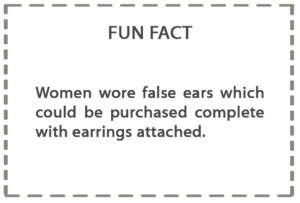
THE PAISLEY CRAZE
- A huge fashion trend that crossed “Haute Couture”, “Tailor Made”, ready-made, & mass produced fashions of the time were paisley shawls & piano shawls of paisley
- Paisley was a specific pattern of color & weave, based on Middle-eastern, Asian, & Eastern designs
- Paisley was used in high fashion for the elite & wealthy
- Paisley shawls also appealed to the mass market of the middle class
- Lower classes would embrace it later after it became in common use at lesser cost
- Paisley originally came from Edinburgh, Scotland in about 1845
- The first paisley shawls were of wool & silk
- Beautiful flimsy silk gauze examples, with bright clear colors were printed for evening wear for the middle & upper classes
- Heavier shawls of wool & silk with light colored centers were used for summer wear, & dark centers for winter
- Printers copied the designs of the woven examples, using wooden blocks & later blocks with the pattern lines inlaid with metal
- Shawls from Scotland were the height of fashion through the early 1800’s
- Norwich, Paisley, Glasgow & other towns printed shawls which were immensely popular
- Great Britain was able to reduce production costs through sub–division & specialization of labor of their mass production textile industry that Scotland did not have
- By 1850, Edinburgh Scottish paisley manufacturers could no longer compete with English Paisley & stopped producing shawls
- Norwich & France continued to produce very good quality examples forward to the present
- They were a favorite wedding present for all classes
- Passed through generations, paisleys were worn from infancy to old age
- They went out of fashion in the 1870’s when they became associated with the elderly
AN ATTEMPT AT BLOOMERS
- A third key trend in this era that never took off were Amelia Bloomer’s “bloomers”;
- “Bloomers” were pantaloons worn under a loose fitting blouse-like tunic intended to take women out of corsets while still keeping her modestly covered
- Bloomers were an attempt to simplify the growing complexity of fashion & its understructures, & it failed miserably until 50 years later when the advent of the bicycle demanded women wear something with a split leg

—— SPECIFIC FASHIONS ——
CRINOLINE SILHOUETTE
- By the 1850’s the term “crinoline” applied to the silhouette as well as the item
- A crinoline was an undergarment structure which further expanded & stiffened the starched petticoat of the previous era
- It widened the bottom of the profile tremendously, creating a wide shouldered, tiny-waisted, & hugely exaggerated hourglass shape of a bell
- “Belle” (“beautiful” in French) was a term appropriately applied to women of the American south who wore the skirts & structures
- Leading up to 1850, a crinoline was a stiffened or structured petticoat designed to hold out a woman’s skirt
- The first crinolines were made of horsehair (“crin”), cotton, or linen
- “Crinoline” also meant the hoop skirts that replaced the crinolines in the 1850’s & 1860’s
- NOTE: In form & function, hoop skirts were very much like 16th &17th century farthingales & 18th century panniers in that they were made of stiff structural materials combined with the horsehair & fabric to hold the skirts into specific (large) silhouettes
- Crinolines were worn by women of every social standing & class, from royalty to factory workers
- Their use was subject to media scrutiny & criticism, & there were many caricatures, jokes, & satires about them in magazines like “Punch” at the time
- Crinolines could be hazardous, as they were extremely flammable
- Other crinoline hazards included hoops getting caught in machinery, carriage wheels, gusts of wind, or other obstacles
- Crinolines & the later hoops allowed skirts to spread wider than ever, up to 6 yards (18′) in diameter at their peak in size & depth in 1857
- The steel-hooped cage crinoline was patented in 1856
- Steel-hooped cages were distributed by agents, intensely marketed, & mass produced in huge quantities by factories in Europe & the US
- Whalebone, cane, gutta-percha, & inflatable caoutchouc (natural rubber) were used for hoops, although steel was the most popular
- By 1860, the hoops began to reduce in size a bit
- The smaller crinolette & the bustle had largely replaced the crinoline by the early 1870’s
BODICES
- The separate blouse & skirt was introduced in this timeframe
- Lines shifted from the vertical to the horizontal on top as well as on the bottom of the silhouette, assisted by shorter, wider bodices
- Women’s 1840’s day dresses had boned bodices with dropped shoulders
- Dresses had a fan-front (gathered) bodice that formed a point below the waist
- Dresses had piping at the waistline, armscye, neckline & shoulder seams.
- Dresses had much less ornamentation than the previous era
- Bodices were worn off the shoulder
- They featured a rigidly boned elongated shape with a waist that formed a perfect point in the front
- Shoulders were extended below their natural line
- Generally necklines were worn high during the day & wide in the evening
SLEEVES
- A new triangular, cone-shaped silhouette emerged featuring new pagoda sleeves
- Huge sleeves had suddenly collapsed in 1836
- The new form-fitting sleeves were sometimes so tight that tiny pleats were inserted at the elbow to aid in movement
- Sleeves in the 1840’s were short & tight with either puff decorations of lace trimming
SKIRTS
- In about 1852, skirts become even fuller than the previous era when they had widened to a “bell shape”
- It was still a “bell shape”, but a much larger “bell” formed by cartridge pleating
- Horizontal flounces or tucks were added to the base skirt to give it width & volume
- Trimmings of tucks & pleats were used to emphasized the new line
- Skirt hems lowered to the floor
- Starting from the mid 1850’s until the end of the century, women’s skirts & understructures continued to get more drapery, a more layers, more stiffening, & more complexity
- As the era progressed towards 1857, the skirt became very domed in silhouette, requiring yet more petticoats to achieve the desired shape
- The trend to get more & more ornate continued into the 1860’s
FABRICS & TRIMS
- There were many more fringes, beads, bugles, & bows with ruchings, loops, & swirls added as time progressed
- Solid, colored fabrics were more in tune with the new solemnity of the era
- Colors shifted to darker tones
- Prints & patterns gradually were introduced & became the norm
- The huge expanses of fabric were crying out for visual interest which large plaids & border prints provided
- Fabrics were the same stiff textured cloth as previous eras in winter or cool climates
- Light cottons were typical in summer
- Bright printed & woven fabrics were popular
- Daytime colors were brown, rust, gray, & green & included Scottish plaids, following the lead of Victoria who loved them & wore bright authentic plaids in silk to social functions
- Pale pastels were for evening
- The designs of the main dress were repeated in matching pelerines
UNDERGARMENTS
PETTICOATS
- Multiple layered petticoats & crinolines provided the fullness of the desired silhouette over the very tightly laced corset
- Numerous petticoats were worn
- The more the crionoline was worn, the less petticoats were worn
- Some stiffening was used to support the skirts, but with the advent of the crinoline, only 1-2 petticoats became necessary
- 2 petticoats were preferred for modestly, as the crinoline did not count as it might sway or blow up revealing the naked woman beneath, or at least an ankle or foot
- Petticoats were decorated with “broderie anglaise” which was tucking & lace
CORSETS
- The corset returned in full force with intent to mold the body into a proscribed shape, rather than to trick the eye
- Waists became smaller & even more tightly laced than in previous eras
- Strong metal grommets made the tight lacing possible
- Previous eras had hand sewn eyelets, which would not have taken the stress
- Center backs & fronts of the corset had additional metal “lacing bones” to take the stress of lacing off the fabric
- New innovations in innovative “busk” closures for front & back made the entire garment much stronger & durable
- Design was flexible with many construction methods available
- By the 1850’s, there were 4 basic corset shapes, with variations by intended activity
- There were corsets for sports, riding, maternity, evening, & travel based on the 4 main concepts
- The 4 corsets all had in common a design which produced a wide & very round bosom with a tiny waist
- No emphasis was made on the hips except to make the corset long enough so that it sat comfortably on the waistline
- Gussets that had been present since the 1790’s in corsets disappeared, to be replaced by seaming
- It was the new shaping of seams that would have a major effect on corsets until the end of the century
- In general, all corsets of the time had colored outer fabrics & a white lining
- Sateen & jean “couteil” fabric was produced in America specifically for corsetry
- Silks, satins, & batistes for decorative outer layers were made in Italy
- Nettings were used for summer corsets
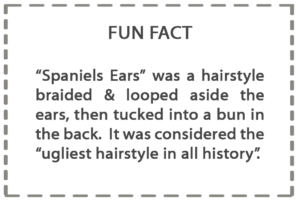
HEADGEAR
- Hair was neatly pulled back into a snood. Snoods were lace or linen coverings over most of the head or at least the back of the head, such as food service workers wear now
- Snoods were worn in the evening too, but they were ornamented with pearls or other decorations for formal occasions
- Hats were now small & worn tipped forward, as introduced by Eugenie, Empress of France
ACCESSORIES & ODDITIES
- Women wore a little rouge, powder, & eyebrow pencil
- Less proper ladies wore pearl & violet powders & rouge
- Women wore false ears complete with earrings
- Parasols & pouch bags with wooden handles were carried by every woman
- Gloves were worn constantly for each & every situation except meals when they were discreetly placed next to the napkin ring
- Gloves were made of lace or silk net; often worked with gold threads for the upper classes
- Early Victorian jewelry included a ribbon around the forehead with a jewel in the center (“ferronniere”)

—— ACTUAL GARMENTS FROM ERA ——
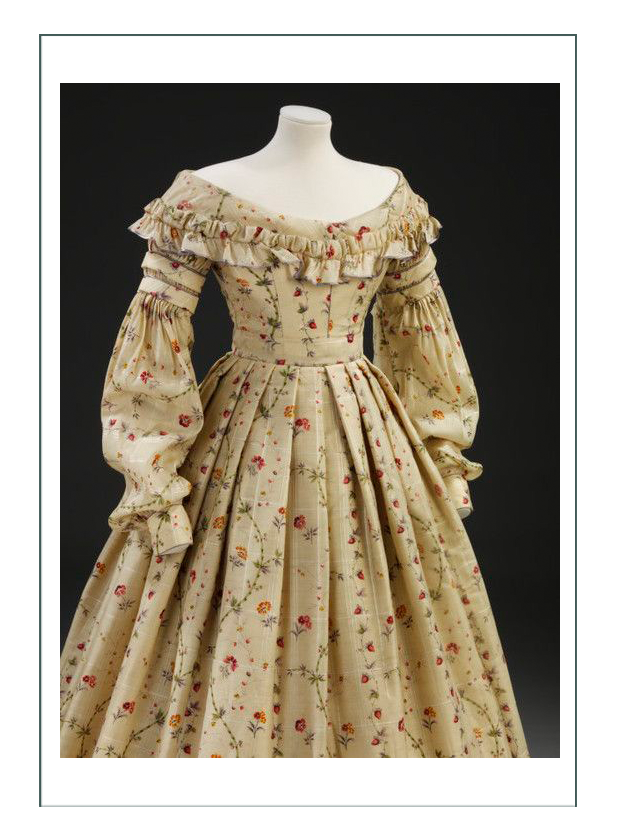
—— (above) “Basic Gown 1838” ——
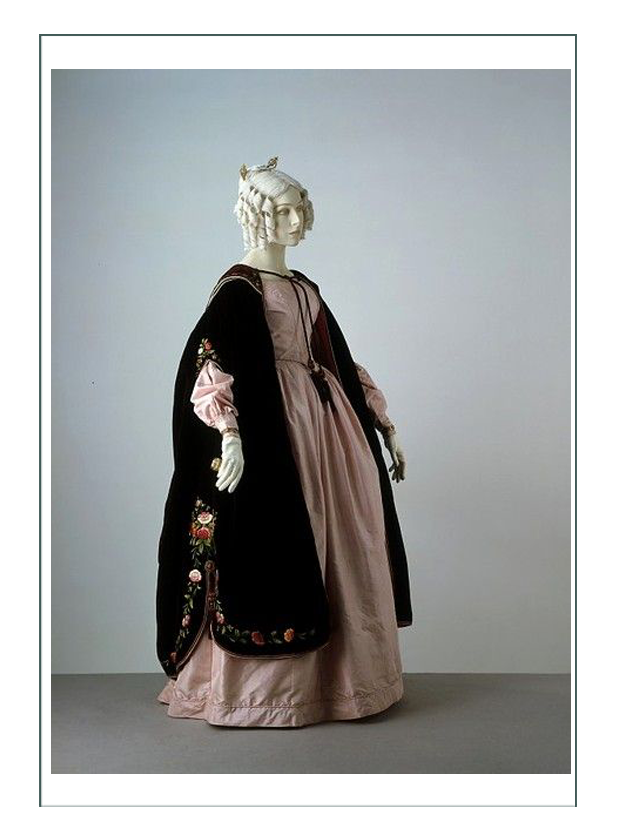
—— (above) “Dress and Mantle 1840” ——
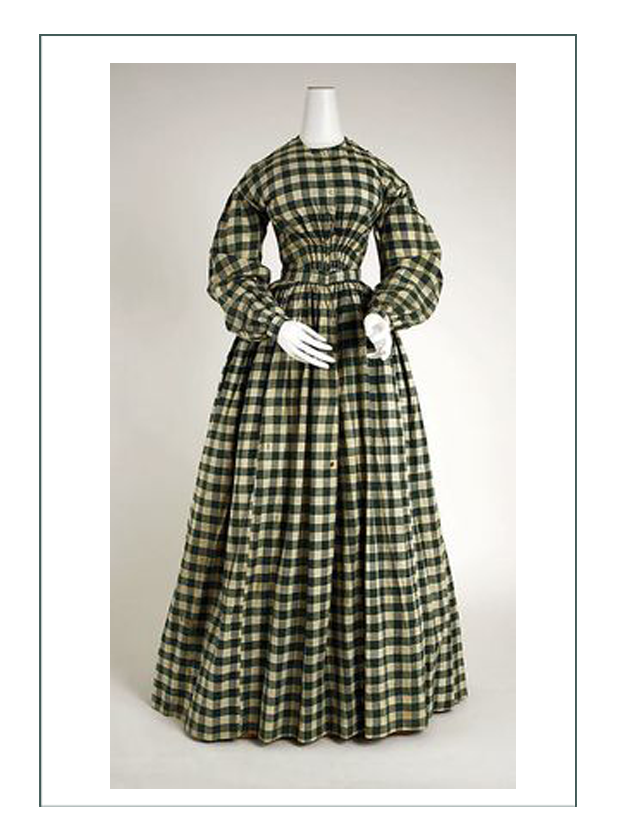
—— (above) “Cotton Day Dress 1840” ——
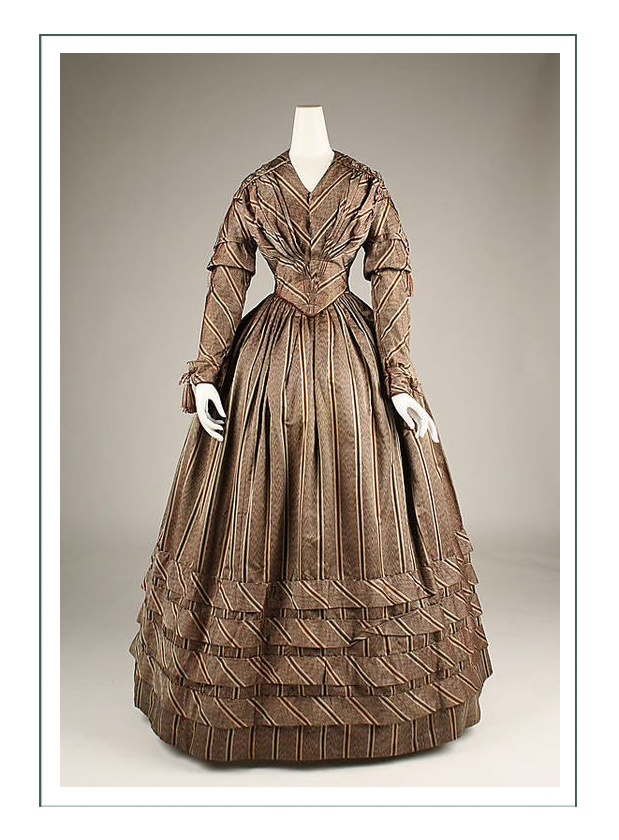
—— (above) “Striped Silk Visiting Gown 1841” ——
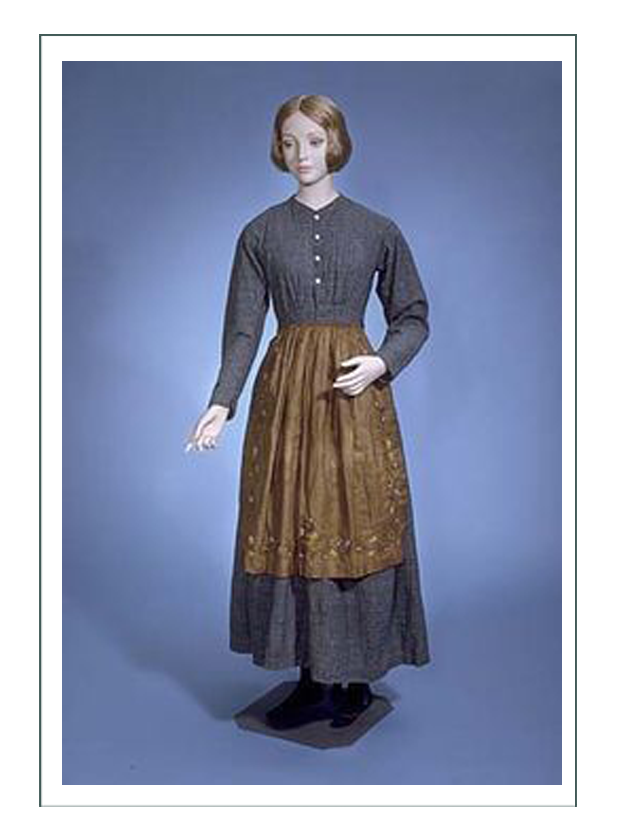
—— (above) “Hired Help 1845” ——
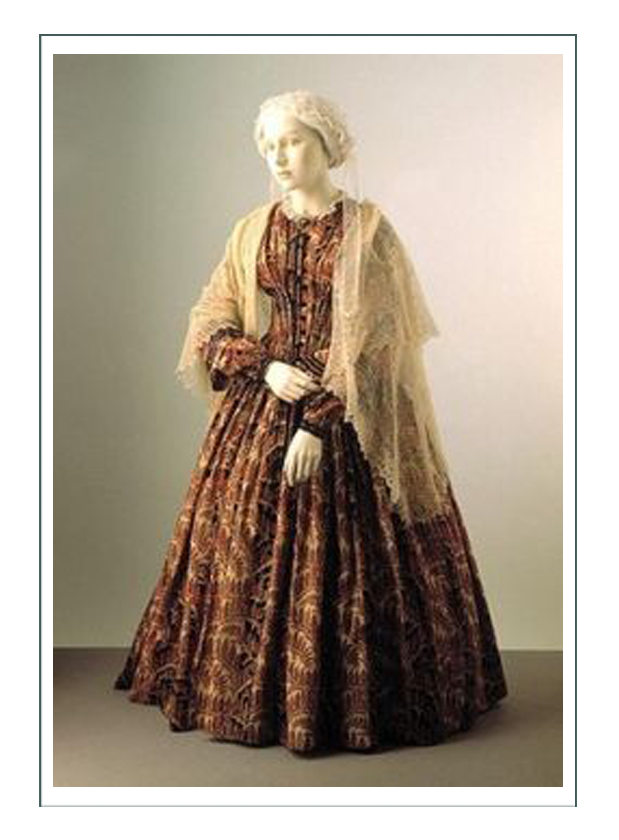
—— (above) “Visiting Dress 1848” ——
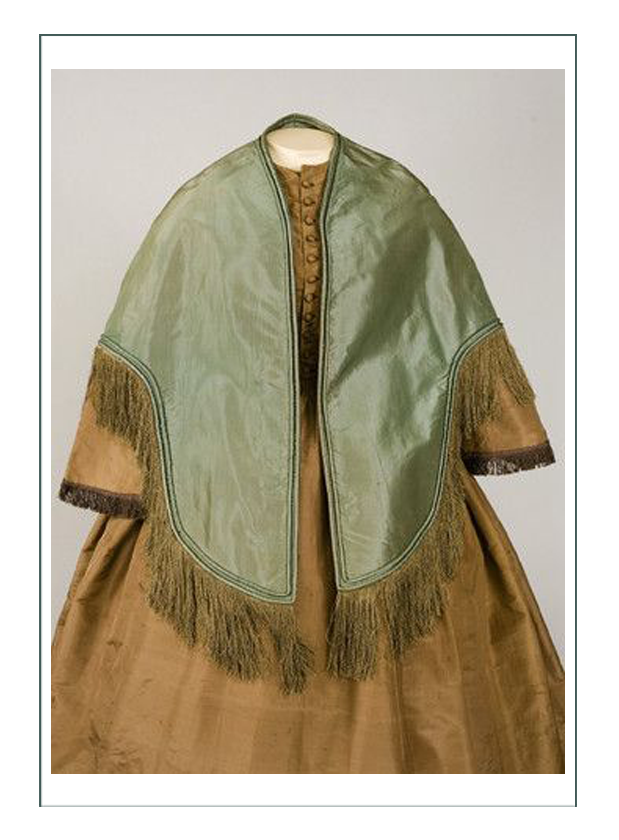 —— (above) “Mantle 1850” ——
—— (above) “Mantle 1850” ——
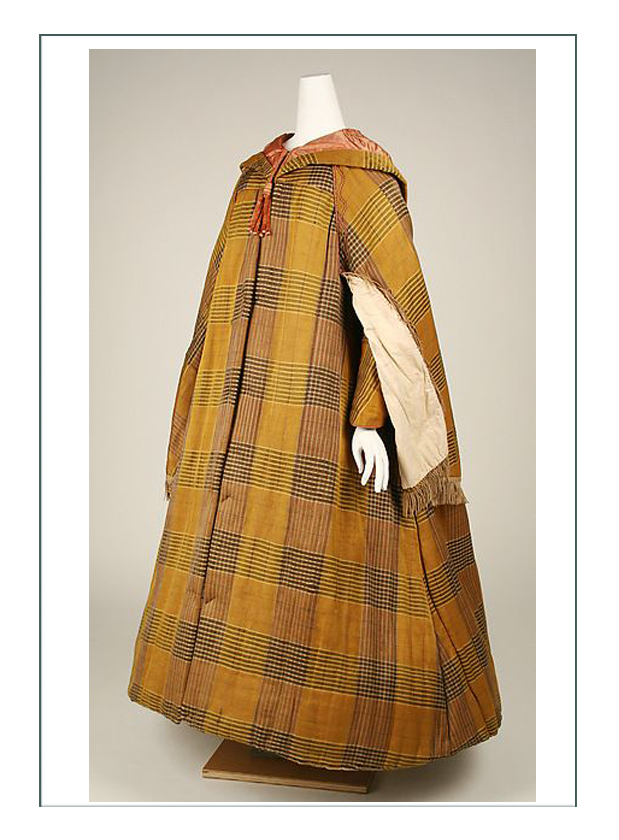 —— (above) “American Made Cloak 1850” ——
—— (above) “American Made Cloak 1850” ——
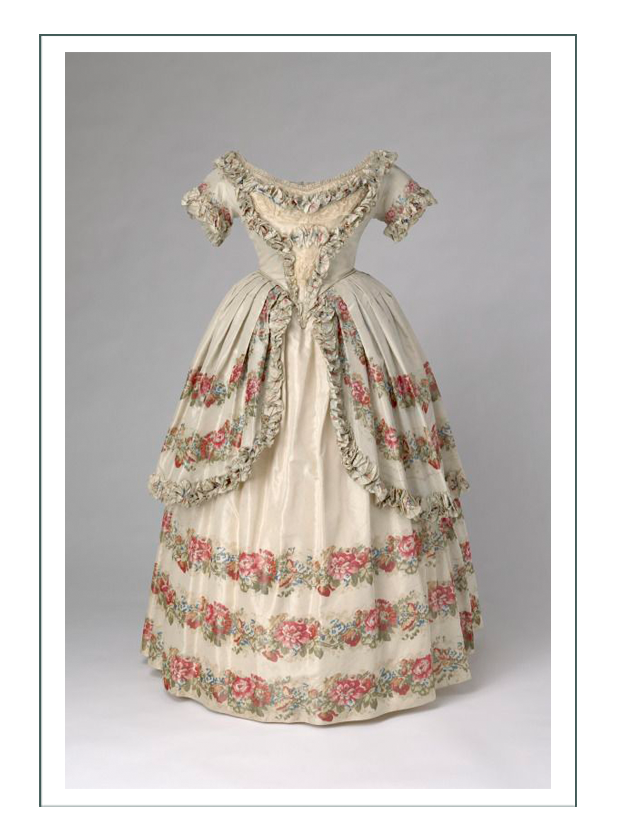
—— (above) “Queen Victoria’s Ball Gown 1851” ——
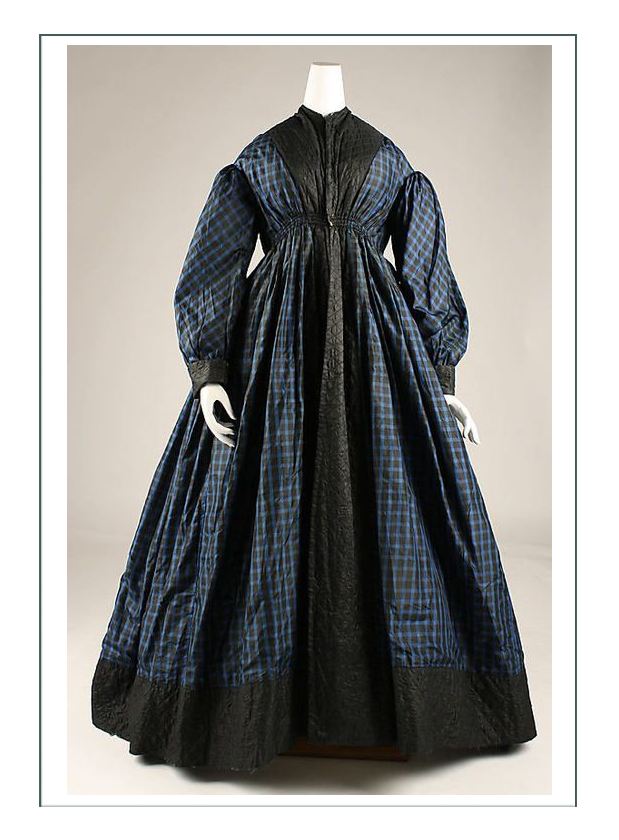
—— (above) “Winter Day Dress 1851” ——
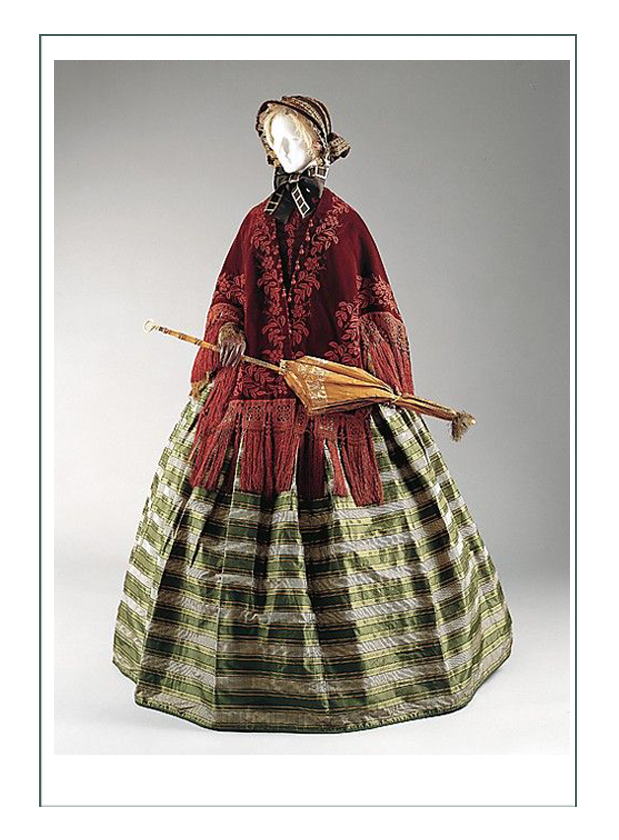
—— (above) “Traveling Ensemble 1851-53” ——
Click date below to go to a different era. We can replicate most ANY garment you see!
